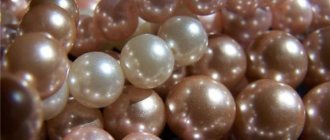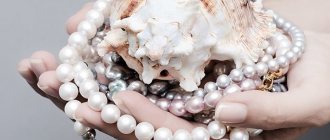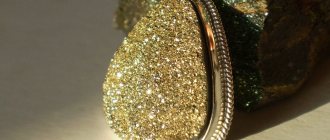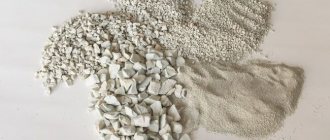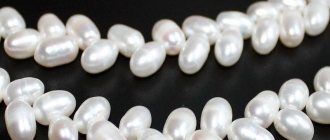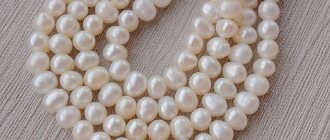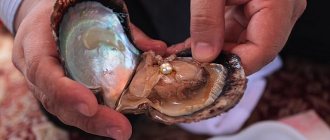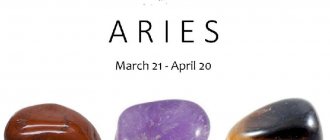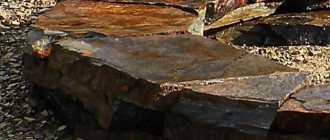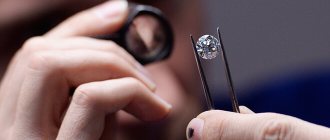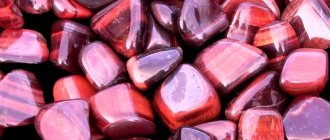Pearls are perhaps one of the most famous natural stones. In many cultures it was valued for its beauty and unusual properties. The Slavs called such a stone “tears of joy.” There are sea and river pearls. Each of them has features. Often on the shelves you can find pearls cultured in freshwater reservoirs.
Education and mining
Sometimes there is something foreign in the body of a freshwater mollusk. This is where the pearl is formed. It usually appears in the area of the valve closing muscle or on the upper part of the body fold (mantle).
Mother of pearl covers the inner wall of the shell. When a foreign particle enters, for example, a grain of sand or an insect larva, the nerve endings of the mollusk become irritated. As a response, the epithelial tissues divide and a special sac appears - a cyst. Next, the mantle secretes nacre, which forms a pearl.
Sometimes a clot of mother-of-pearl appears without a foreign body. It is necessary for the epithelial cells to be inside the mantle. This happens, for example, due to injury or pathology.
In fresh waters - lake and river - most stones are obtained from mollusks of the genera Margaritifera and Dahurinaia. First of all, these are pearl mussels: European, Daurian, Kamchatka. Pearls are also found in toothless and pearled pearls.
Freshwater pearls take three to twelve years to mature. The timing depends on the species, environment, and age of the mollusk. The older he is, the smaller the pearls. River mollusks produce small, irregularly shaped minerals.
In the 19th century, a lot of river pearls were mined in the Russian Empire, especially in the north of the country. Nowadays, minerals of different origins end up in jewelry workshops. They are mined and grown in Russia, China, Germany, Great Britain, and the USA. Cultivation is practiced on farms.
You can try to find a river pearl on your own. But this will take a lot of time and does not guarantee a positive result. The shells are collected from the bottom. A sign that they contain a precious mineral are irregularities or tubercles on the valves.
LiveInternetLiveInternet
Different cultures have preserved legends about how a pearl appears. The Indian philosopher Swami Vivekananda in Bhakti Yoga gives the following legend:
The pearl oyster lives at the bottom of the sea and rises to the surface to catch rainwater when the star Swati (Venus) rises. Then she sinks to the bottom again, where a magnificent pearl emerges from that drop. And according to Slavic legends, not every drop of water that falls into the shells can become a pearl, but only the one that flows from the corolla of a water lily.
The Gnostic text Physiologus tells us that the shell rises from the sea in the morning hours at dawn.
“And the shell opens its mouth and absorbs the heavenly dew, the rays of the sun, the moon and the stars. And gives birth to a pearl from the highest sources of light...” The most amazing thing is that in all ancient cultures, a pearl is an image of the human soul , illuminated by the divine spirit, or a combination of two “elements”: Water and Fire.
The first symbolizes the earthly soul, and the second symbolizes the heavenly spirit. The pearl in the shell is the soul enclosed in the body. The Gnostic poem “Hymn to the Pearl” has been preserved, which tells about the real drama of the soul. The legend tells of a young man sent to earth by his Father, who lives in Heaven, to fight a terrible serpent and take a pearl from him from the bottom of the sea and return it to Heaven. Before sending the young man away, they took off his robe of glory and purple mantle and wrote a covenant in his heart:
“When you go down to Egypt and get that Pearl that lies in the middle of the sea, which is surrounded by the magic serpent, you will again put on the clothes of glory and your mantle and ... you will be the heir of our kingdom.” For many centuries, Egypt was the center of ancient wisdom, secret knowledge, where, according to legend, not only eastern sages, but also many ancient philosophers studied. And the pearl that needs to be rescued from the “mouth of the Serpent” is the light of a soul abandoned in a foreign land, a jewel. After all, the soul of a person is more valuable than anything else in the world. The New Testament says: “...what does it profit a man if he gains the whole world and loses his own soul?” The soul is addressed as a “pearl” in order to contrast its value with the worthlessness of the transitory world, its brilliance with the darkness in which it is immersed. The human soul, immersed in the waters of life, matter, is entangled in the serpent, which in the symbolism of many cultures was an image of the forces of nature. It is difficult to escape from its captivity, because, having descended to earth, the soul forgets about its origins, carried away by the play of feelings.
Even the divine messenger about whom the poem tells, a young man called to free the Soul from the captivity of matter, is not allowed to avoid the period of oblivion of the soul. And he would not have been able to remember why he was here if he had not received his Father’s letter:
“Awake and arise from your sleep and consider the words of our letter. Remember that you are the king's son: see whom you serve in slavery. Remember the Pearl, for the sake of which you were sent to Egypt. Remember your garments of glory..."
A pearl is a symbol of the inner center, purity. And it is also a symbol of secret knowledge, which is not revealed to a person just like that, without persistent aspirations and searches. The pearl symbolizes light in the darkness.
Just as a pearl is hidden from us in a shell, so the inner light of the soul and the light of knowledge are hidden from us, and to get to them requires enormous effort, often suffering and tears, which the pearl also symbolizes. After all, its formation is a deviation from the normal biological process. It appears only if a foreign body, a piece of dirt, gets into the shell of the pearl oyster. At the same time, the mollusk “cries”, suffers, washes this “dirt” with tears, turning it into a beautiful pearl. Pearls are considered a gemstone, but are not a mineral. A pearl is formed as a result of the hardening of secretions produced by some types of mollusks when gravel, a grain of sand, a piece of shell, or tiny insects enter the shell. The pearl mussel secretes nacre (from the German Perl - “pearl” and Mutter - “mother”, that is, “mother of pearls”) in the form of spherical layers of aragonite (calcium carbonate).
This is how the pearl gradually appears. Its color can be different: white, blue, yellow, brown, greenish, pink, black. Sizes can also be very different: the size of a pinhead or the size of a chicken egg and even larger.
The largest pearl, weighing 340 carats, is kept in the Geological Museum in London. And the most famous and most beautiful pearl “Pilgrim” (“Pelegrina”) was found off the coast of India - it is the size of a walnut and has a perfectly spherical shape. In pearl fishing areas, only one out of 30–40 shells contains pearls. But sometimes there can be one, two or even more pearls in one shell.
It’s the same with people - not everyone has a sparkling soul. But it happens that one person has many “pearls”. And their light is brighter, the more tears are shed and consoled.
Types of freshwater pearls
There are two types of river stone: natural and cultivated. The first is sought in habitats of suitable mollusks. Such pearls are rarely found on sale, since mining them is unprofitable. Although large natural specimens, if they are of good quality and shiny, are the most expensive. For example, in 2008, a single freshwater pearl was sold at Christie's for $713,000.
The cultivated product is obtained on special farms. The foreign body is implanted independently into promising species. The implant consists of mother-of-pearl, which speeds up the process, but in nature pearls usually mature faster. Then the oysters are sent into the pond, surrounded by nets.
The undisputed leader in the cultivation of freshwater pearls is China. They began to develop the direction here in the 70s of the last century. Mussels produce 15-35 pearls at a time. Just one shell of a mollusk brings 3-4 “harvests”.
Farm-grown pearls tend to be smooth and have more regular contours. It is difficult to distinguish them from natural ones. The following types are distinguished by shape: circle, pear, drop, oval, button, baroque.
More often you come across mother-of-pearl stones, less often - green, gray, brownish. There are no blacks. Freshwater pearls have approximately 120 shades. The color depends on the characteristics of the foreign particle, the composition of the water, and the type of mollusk.
Stones come in the following sizes:
- Pearl dust. Diameter - up to 3 mm. It is often used to decorate expensive clothes.
- Beads - stone up to 3-5 mm. Such specimens can be grown on farms in 1.5–2 years. They are used to make jewelry.
- High-quality freshwater pearls are the most expensive. It is more difficult to grow. Size - 5-10 mm in diameter. Better suited for jewelry.
Some species are sometimes confused with saltwater pearls. When grown on modern farms, their sizes have become comparable. Colors and other features are often similar. Differences between sea pearls:
- rounder and smoother surface;
- brightness, river - dimmer;
- wide palette of colors - from white to black;
- The mother of pearl layer is thinner.
Sea pearls
Natural black or bright pink river pearls are not found.
What types of pearls are there?
Today, pearl lovers have access to several options for the material, which has different origins.
Natural
For centuries, pearls have been extracted from water. It can be marine or freshwater (river).
- Nautical. The rarest, most expensive species come from the warm tropics - the waters of the Persian Gulf, Ceylon, and Japan. But only one sea shell out of hundreds raised to the surface contains a high-quality pearl.
- River. Freshwater material is easier to obtain, there is more of it, so it is more accessible and cheaper than sea material. Freshwater mollusks form several pearls. They are smaller than marine ones, less shiny, irregular in shape, with a relief grooved surface and bulges.
Natural specimens are complemented by a variety that combines a natural process and human labor.
Cultured
Not every shell creates a pearl, but it is impossible to determine this by external signs. Therefore, people collected and opened all the shells they found. This predatory attitude towards marine resources led to a ban on fishing. However, a solution was found even earlier.
The mineral began to be grown on “farms” or “plantations”, reproducing the natural conditions under which pearls are formed in the mollusk. That is, a shell plus a warm sea. In essence, these are sea pearls obtained purposefully, and not spontaneously.
Majorca
The variety created in a factory using mother-of-pearl is classified as organic. This is an intermediate level between natural, cultivated and artificial material. We wrote more about it here.
Artificial
Natural and cultured pearls are rare, expensive, and not available to everyone, so several types of artificial analogues have been created.
Pearl beads come in glass or plastic, any size and color. Their shine is brighter than natural ones.
Healing and magical properties
The stone is used in medicine. The calcium carbonate in its composition normalizes the acidity of the stomach. Pearls are also used:
- to strengthen the nervous system;
- for hypertension;
- for healing the kidneys and liver;
- for eye diseases.
Different peoples attributed magical properties to pearls. The Europeans expected longevity from him, the Chinese - prosperity, the Arabs - protection from the evil eye.
Pearls do not always help a person. Decorations with them suppress the flight of thought of travelers, actors, and writers. The mineral plunges you into a world of dreams, sometimes gloomy ones. Capable of breaking a psychologically weakened person. It brings melancholy to the lonely. It is not advisable for children to wear products with mother-of-pearl beads.
Brings fidelity, peace and understanding to couples. Resists betrayal and unkind thoughts. In this case, the jewel becomes tarnished.
How to distinguish natural from fake
There are products made from fake pearls on sale. In addition, there are now technologies for growing beads without shellfish. It is important to remember the differences:
- Natural stones should be cool to the touch.
- If you throw real pearls on a table, they will easily bounce off the surface.
- You can lightly rub two stones against each other until a powder appears. Scratches on natural pearls disappear when you run your finger over them. On a fake, the mother-of-pearl may be worn off, revealing another material behind it.
- Gems are heavier.
- Counterfeits are often cheaper.
- Fakes have traces of paint around the edges. They look unnatural: the shine of the stone is too bright, the shape is spherical, too regular.
- Natural pearls differ from each other, artificial pearls can be the same in shape and color.
Stone selection
Even good freshwater pearls have flaws: spots, dents, bumps. Quality is determined by the main characteristics: size, origin, shape, brightness and others. Expensive copies undergo examination. The standards were developed by Americans. The assessment is based on 6-7 parameters. So, round ones are less common, so they are more expensive. River pearls are valued less than sea pearls.
When choosing jewelry, it is important to know:
- Jewelry where the size of the beads gradually increases or decreases is considered more beautiful and of higher quality.
- The pairing, geometry of parts, and overall impression are important.
- River pearls in jewelry sometimes come in different colors or are combined with other precious stones.
- Sets of beads, earrings, and rings are popular.
- Flaws are better visible against a dark background under strong but diffuse lighting.
Freshwater pearl jewelry is beautiful and usually inexpensive. They can be worn for a long time without loss of quality and passed on by inheritance.
Varieties
There are hundreds of variations, the following are popular:
- Akoya. Marine material, grown in Japan and China, produced by oysters of the same name. The most popular variety, combining the canonical shape and color. No larger than 8 mm, but refracts light with a coefficient that creates the effect of internal glow.
- White. Product of marine silver-lipped clam from Australia, Indonesia, Philippines. Oysters of this species are demanding and difficult to tame, so their product, which reaches a diameter of 2 cm, is exclusive and expensive.
- Golden. Grown in the same place as white, plus Myanmar. Up to a centimeter in diameter, the dense top layer of mother-of-pearl makes the shine exquisitely muted.
- Black. It is produced in many regions, but is considered royal, therefore more expensive than others. In fact, black pearls range in color from gray-silver to black, with blue, purple or green tints. Diameter – 0.8–1.8 cm. Trade is concentrated in Tahiti.
Cultured material is grown in the same water and pearl oysters as natural material. It is beautiful, has natural properties, but is several times cheaper. And Mikimoto today is a global luxury pearl brand.
Majorca
The technology almost copies the processes in the mollusk. The glass or porcelain core is immersed in a composition of pearl powder, fish scales, oil and natural pigment (for colored material).
The bead is dried, then the process is repeated 30–45 times. The cycle takes 15–35 days. The surface is covered with mother-of-pearl and treated with ultraviolet light. The cost of the finished material is determined by the number of layers.
